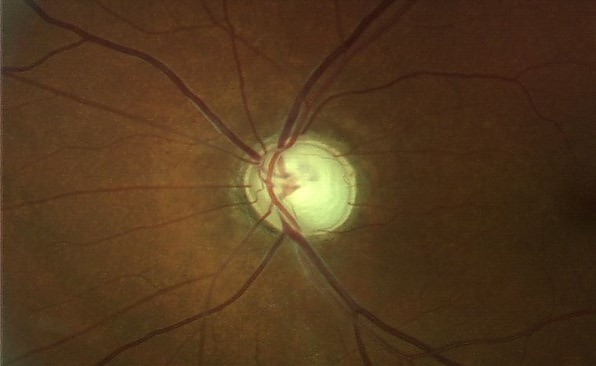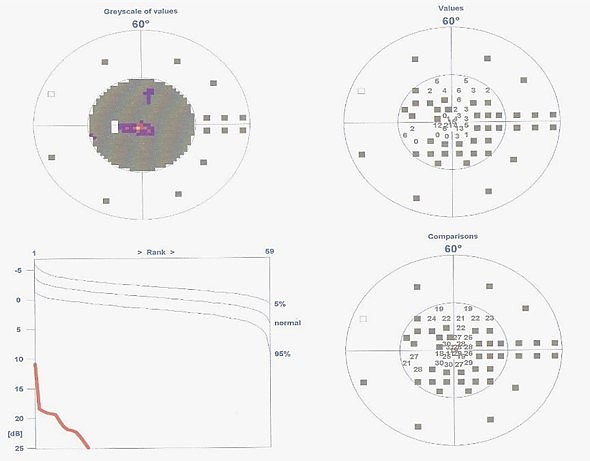Disorders
Glaucoma Glaucoma
What is Glaucoma?
Glaucoma is a progressive and chronic asymptomatic ocular disease, being one of the main causes of blindness worldwide.
In this pathology the loss of vision is a consequence of the progressive destruction of the optic nerve, made up of fibers that are responsible for conducting the images to the brain. The destruction of these fibers leads to the progressive diminution of the visual field that is contracting, becoming tubular until arriving at the blindness. Early diagnosis of the disease is critical.
What are the symptoms of Glaucoma?
In most cases, glaucoma is asymptomatic until the later stages of the disease. At that time, the visual field becomes progressively tubular and the person begins to have limitations in his normal daily activity. For example, in driving a person has to move their head and eyes to find the objects they are looking for, leaving a normal peripheral vision.
Risk Factors for Glaucoma
- Ocular hypertension - In glaucoma there is an increase in ocular tension that leads to the destruction and injury of the fibers of the optic nerve. Ocular tension increases because the fluid circulating inside the eye (called the aqueous humor) accumulates, either by increasing its production or by decreasing its drainage. This latter aspect occurs by blocking narrow channels located inside the eye (trabecular meshwork). Thus, the accumulation of this liquid within the eye leads to increased pressure and consequent damage to the optic nerve.
- Family history of glaucoma;
- Diabetes and Hypertension;
- Myopia;
- Sleep apnea;
- Black and Asian individuals.
Types of Glaucoma
Open Angle Glaucoma
It is the most frequent form of Glaucoma (90%) and usually appears after the 40 years of age. It results from decreased drainage of the aqueous humor through the narrow canals of the trabeculae, which leads to an increase in ocular tension.
Closed angle glaucoma
It is a more rare and serious form of Glaucoma. It is an ophthalmological urgency. In this pathology, the iris blocks the drainage channels of the aqueous humor, causing a sudden increase in ocular tension, accompanied by intense ocular pain and blurred vision. May have headache, nausea and vomiting.
Congenital Glaucoma, juvenile
There are several types of Glaucoma that can occur at birth and in youth.
Secondary glaucoma
Other secondary glaucomas are associated with trauma, post-surgery or diseases (diabetes and ocular inflammation), as well as after certain therapies such as corticosteroids or antidepressants.
Diagnosis and treatment
The best way to treat glaucoma is through its early diagnosis, hence the importance of regular consultation of Ophthalmology, especially after 40 years of age.
The main recommended tests that can be performed at the Portuguese Retina Institute are:
- Measurement of eye strain;
- Examination of the ocular fundus (for visualization of the optic nerve and detection of signs of injury);
- Gonioscopy (for study of the camerular angle and classification of open / closed angle glaucoma).
If necessary, additional structural and functional tests may be carried out, in particular:
- Static computerized perimetry (to study the visual field);
- Scanning laser polarimetry (Gdx);
- Optical coherence tomography (for the study of the optic nerve and layer of nerve fibers, referred to as OCT);
- Pachymetry (to evaluate the thickness of the cornea).
The treatment of Glaucoma aims to block the progressive lesion of the optic nerve as early as possible, taking into account that the lesions are irreversible. It could be:
- Medical - with drops or tablets to reduce the production of the aqueous humor or increase its flow through the camerular angle.
- With Laser:
- Trabeculoplasty: Usually used in open-angle glaucoma, when medical therapy is not effective. Structurally changes the anatomy of the angle, optimizing drainage of the aqueous humor;
- Iridotomy: used in closed angle glaucoma. It produces an orifice in the iris, contrary to the block caused by it, at the level of the camerular angle;
- Surgical treatment - Usually used when medical treatment and Laser fail. There are several techniques, and trabeculectomy is the most frequently used. In this procedure, communication is established from the inside of the eye to a space below the conjunctiva, in order to divert the aqueous humor and thereby reduce eye strain and control the evolution of the disease.
Request for Consultation
Make your online request here.
1st Consultation - € 85 and following € 80
Genetic Consultation - €90 (Private only)
See our Agreements and Partnerships!


